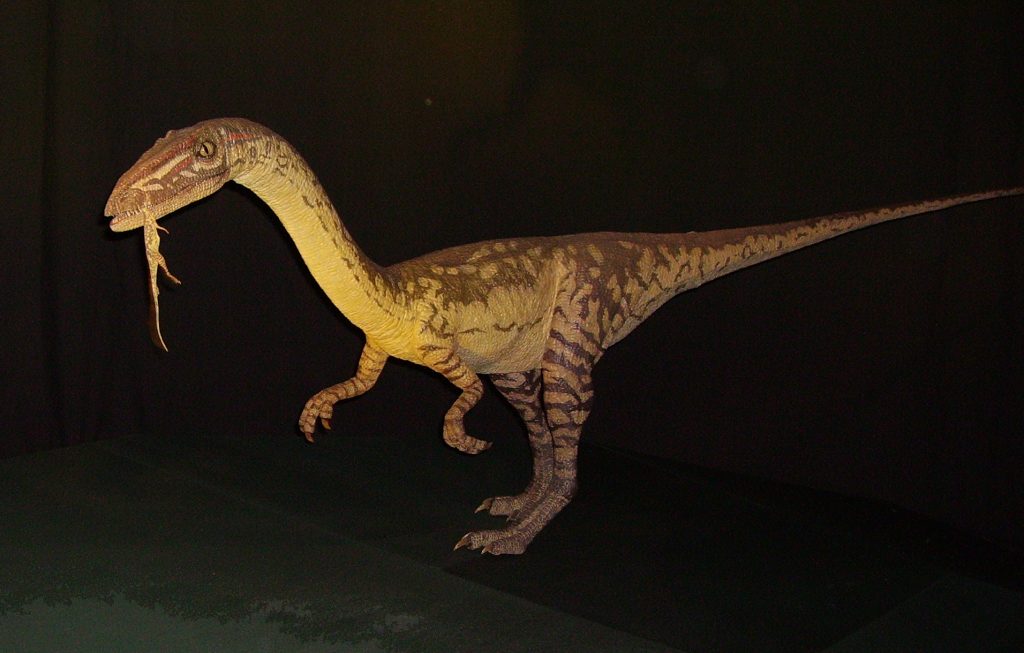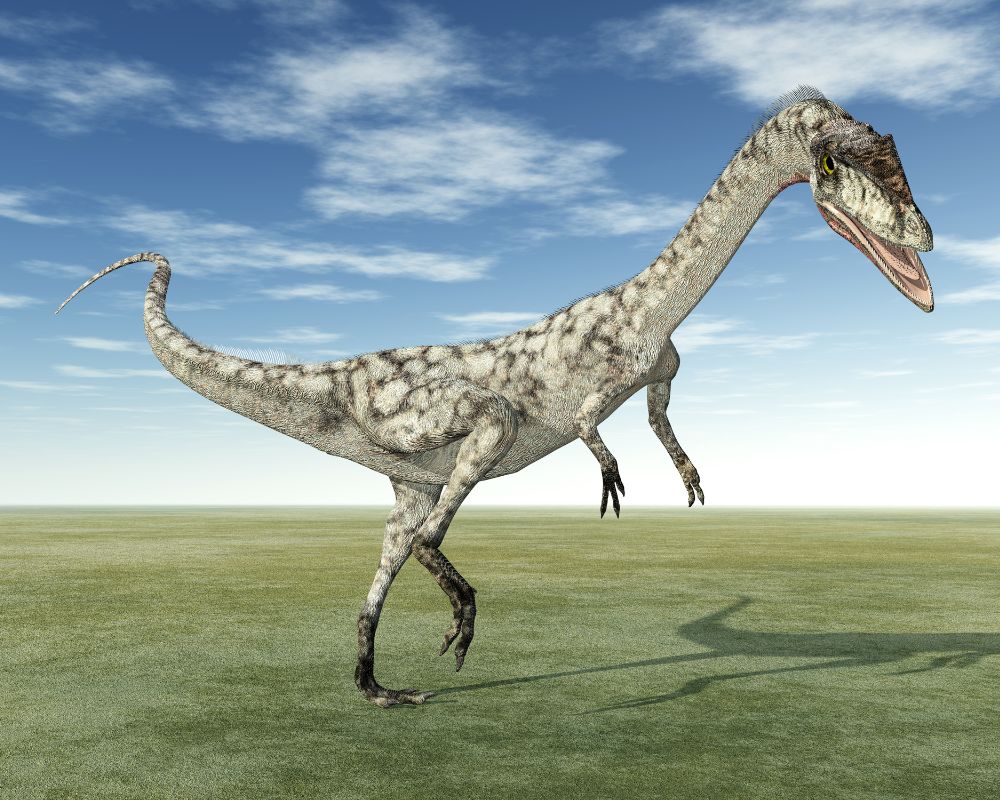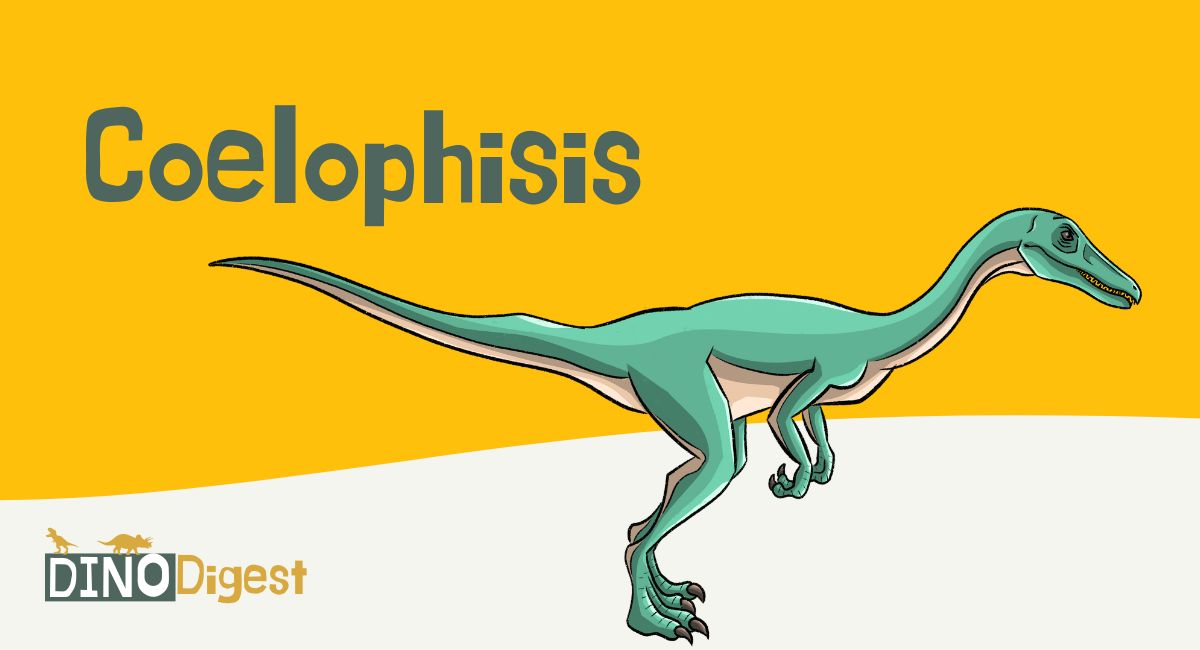The Coelophysis is a species of early dinosaurs with much in common with modern-day birds. These dinosaurs mean business from their sharp eyesight, hollow bones, and quick movements. Fossils of these fierce theropods have shown up in Africa, North America, and even taken a trip to outer space.
Table of Contents
Some Quick Facts About the Coelophysis

| Name | Coelophysis (meaning “Hollow Bones”) |
| Type of dinosaur | Theropod |
| Territory | Grasslands, North America, South America |
| Size | 6 feet long, 3 feet tall |
| Color | Brownish, dark stripes, feathers |
| Interesting Characteristics | Razor-sharp teeth, small forearms |
| Diet | Small reptiles |
| Major Threats | Natural disasters |
The Coelophysis is a species within the theropod dinosaurs family, together with Tawa Hallae, Eoraptor, and Herrerasaurus. These dinosaurs are known for their razor-sharp eyesight and equally razor-sharp teeth. Their hollow bones, keen eyesight, and overall behavior are similar to the characteristics of modern-day birds.
Why Did the Coelophysis Have Hollow Bones?
The Coelophysis isn’t a type of dinosaur but a genus. The Coelophysis bauri is a classification of dinosaurs that lived towards the late Triassic period. The name coelophysis translates to “hollow bones,” precisely what these dinos had. So, why were their bones hollow?
You had to be fast and agile to catch a meal during the Triassic period. Slow-moving predators didn’t have much luck keeping up with quick-moving prey. The hollow bones of the Coelophysis, however, allowed them to stay incredibly fast. The faster a predator could move, the more often it could catch a meal.
These Triassic dinosaurs belonged to a species known as theropods, similar to the Megapnosaurus and Podokesaurus, and, of course, the Tyrannosaurus rex.
How Could You Recognize a Coelophysis?
The movements of a Coelophysis are very similar to a bird without wings. They look like a T. rex, only smaller. If you were to jump into a time ship and admire these creatures (from a safe distance), you would notice that they are smaller than you think.
Fossil remains show that they were only two meters long (about the size of a grown man lying down) and 3 feet tall and only weighed about 60 pounds. Their light weight is similar to that of three watermelons. Given their size, their weight is surprisingly light!
Their light weight is due to their hollow bones. This helped them zip around quickly and snatch a tasty snack in their razor-sharp teeth. They would also use their slender forelimbs to hold their prey down as they ate.
While their teeth were designed to snatch up prey, their arms played a significant role in how they ate. They walked around on their muscular back legs and only used their arms for feasting. Their slender arms may look dainty, but a singular sharp claw on each hand also helped them catch the meat they needed to survive.
Where Did The Coelophysis Live?

In the later part of the Triassic period into the early parts of the early Jurassic period, the Coelophysis lived in parts of Africa (Zimbabwe in particular) and some parts of North America. That’s right – if you live in North America, there’s a good chance a Coelophysis hunted prey right in your backyard (200 million years ago, though). They have been discovered from Connecticut all the way to New Mexico and Arizona.
Paleontologist Edward Drinker Cope spotted the first fossil records in New Mexico in the late 1800s. It was an exciting find, and an entirely new species of dinosaur that had never been seen before was unearthed.
At first, the C. Bauri fossil discovered in New Mexico didn’t provide a clear picture of the dinosaur. The fossils were only a glimpse into a new genus of dinosaurs; there needed to be more fossil records to recreate a complete image.
Where is the Coelophysis’ Graveyard?
Then in 1956, there was a fantastic discovery at the Ghost Ranch in New Mexico. A paleontologist named Edwin H. Colbert from the American Museum of Natural History discovered an entire graveyard of perfectly-preserved Coelophysis. Many believe that it was a flash flood that took out a whole flock of these small theropods.
From the Ghost Ranch, we learned so much about this fierce predator. Much of what we know today about this late Triassic Coelophysidae comes from the Ghost Ranch graveyard.
What Did the Coelophysis Hunt?
After discovering the Ghost Ranch graveyard, paleontologists found what the Coelophysis hunted and how they hunted. The Coelophysis was a carnivore, or a meat-eater, because it had very sharp teeth and scary front talons for ripping into prey. Their hollow bones also made them incredibly quick, which allowed them to hunt down smaller prey.
The discovery of the graveyard and Ghost Ranch also tells us that they hunted in packs. They would travel together in groups and hunt down small critters like insects and reptiles (AKA Phytosaurs). Sometimes, they would also scavenge off of prey that was already dead.
Some fossil records indicate the Coelophysis may have also been cannibals, which means they ate members of their own family. Bones of other Coelophysis were found inside the stomach of some of the fossil records at Ghost Ranch, although some paleontologists feel that this isn’t true.
Is a Raptor a Coelophysis?
Yes! Think of the Coelophysis as the grandfather to raptors. Many later species of raptors, like the Dilophosaurus, Velociraptor, and Utahraptor, were descendants of the Coelophysis. These species of raptors lived much later than the Coelphysis.
The Velociraptor, for instance, lived 72 million years ago in the late Cretaceous period, while the Coelophysis lived a whopping 200 million years ago in the Triassic and Jurassic period.
Did You Know about Dinosaurs in Space?
Fun fact: the Coelophysis made it to outer space! And no, that doesn’t mean they built a spaceship. In 1998, a fossil of the Coelophysis made history as the first dinosaur taken into outer space. It was carried on the space shuttle Endeavor to the Mir Space Station.

